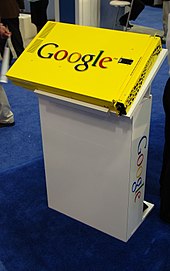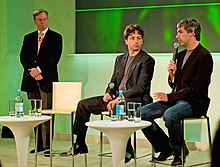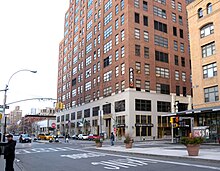On October 2, 2013, Google updated its homepage
In 2003, The New York Times complained about Google's indexing, claiming that Google's caching of content on its site infringed its copyright for the content.[146] In this case, the United States District Court of Nevada ruled in favor of Google in Field v. Google and Parker v. Google.[147][148] The publication 2600: The Hacker Quarterly has compiled a list of words that the web giant's new instant search feature will not search.[149]
Google Watch has criticized Google's PageRank algorithms, saying that they discriminate against new websites and favor established sites.[150] The site has also alleged that there are connections between Google and the National Security Agency (NSA) and the Central Intelligence Agency (CIA).[151]
Google also hosts Google Books. The company began scanning books and uploading limited previews, and full books where allowed, into its new book search engine. The Authors Guild, a group that represents 8,000 U.S. authors, filed a class action suit in a New York City federal court against Google in 2005 over this service. Google replied that it is in compliance with all existing and historical applications of copyright laws regarding books.[152] Google eventually reached a revised settlement in 2009 to limit its scans to books from the U.S., the UK, Australia, and Canada.[153] Furthermore, the Paris Civil Court ruled against Google in late 2009, asking it to remove the works of La Martinière (Éditions du Seuil) from its database.[154] In competition with Amazon.com, Google sells digital versions of new books.[155]
On July 21, 2010, in response to Bing, Google updated its image search to display a streaming sequence of thumbnails that enlarge when pointed at. Though web searches still appear in a batch per page format, on July 23, 2010, dictionary definitions for certain English words began appearing above the linked results for web searches.[156]
The "Hummingbird" update to the Google search engine was announced in September 2013. The update was introduced over the month prior to the announcement and allows users ask the search engine a question in natural language rather than entering keywords into the search box.[157]
Productivity tools
Gmail, a free webmail service provided by Google, was launched as an invitation-only beta program on April 1, 2004,[158] and became available to the general public on February 7, 2007.[159] The service was upgraded from beta status on July 7, 2009,[160] at which time it had 146 million users monthly.[161] The service was the first online email service with one gigabyte of storage. It was also the first to keep emails from the same conversation together in one thread, similar to an Internet forum.[158] The service offers over 7600 MB of free storage with additional storage ranging from 20 GB to 16 TB available for US$0.25 per 1 GB per year.[162]Gmail uses AJAX, a programming technique that allows web pages to be interactive without refreshing the browser.[163] Steve Ballmer (Microsoft's CEO),[164] Liz Figueroa,[165] Mark Rasch,[166] and the editors of Google Watch[167] have criticised the privacy of Gmail, but Google claims that mail sent to or from Gmail is never read by a human being beyond the account holder and is only used to improve relevance of advertisements.[168]
In 2004, Google started opensource software project hosting, called Google Code, which allows developers to download incomplete programs at no charge. Google Docs, another part of Google's productivity suite, allows users to create, edit, and collaborate on documents in an online environment, similar to Microsoft Word. The service was originally called Writely, but was obtained by Google on March 9, 2006, and was released as an invitation-only preview.[169] On June 6 after the acquisition, Google created an experimental spreadsheet editing program,[170] which was combined with Google Docs on October 10.[171]
Enterprise products

Google's search appliance at the 2008 RSA Conference
Google Apps allows organizations to bring Google's web application offerings, such as Gmail and Google Docs, into their own domains. The service is available in several editions: a basic free edition (formerly known as Google Apps Standard edition), Google Apps for Business, Google Apps for Education, and Google Apps for Government. In the same year Google Apps was launched, Google acquired Postini[173] and proceeded to integrate the company's security technologies into Google Apps[174] under the name Google Postini Services.[175]
Other products
Google Translate is a server-side machine translation service, which can translate between 35 different languages. The software uses corpus linguistics techniques, where the program "learns" from professionally translated documents, specifically UN and European Parliament proceedings.[176]Google launched its Google News service in 2002, an automated service which summarizes news articles from various websites.[177] In March 2005, Agence France Presse (AFP) sued Google for copyright infringement in federal court in the District of Columbia, a case which Google settled for an undisclosed amount in a pact that included a license of the full text of AFP articles for use on Google News.[178]
In 2006, Google made a bid to offer free wireless broadband access throughout the city of San Francisco along with Internet service provider EarthLink. Large telecommunications companies such as Comcast and Verizon opposed the efforts, claiming it was "unfair competition" and that cities would be violating their commitments to offer local monopolies to these companies. In his testimony before Congress on network neutrality in 2006, Google's Chief Internet Evangelist Vint Cerf blamed the tactics on the fact that nearly half of all consumers lack choice in broadband providers.[179] Google currently offers free wi-fi access in its hometown of Mountain View, California.[180]
In 2010, Google announced the Google Fiber project with plans to build an ultra-high-speed broadband network for 50,000 to 500,000 customers in one or more American cities.[181] On March 30, 2011, Google announced that Kansas City, Kansas would be the first community where the new network would be deployed.[182] In July 2012, Google completed the construction of a fiber-optic broadband internet network infrastructure in Kansas City, and after building an infrastructure, Google announced pricing for Google Fiber. The service will offer three options including a free broadband internet option, a 1Gbit/s internet option for $70 per month, and a version that includes television service for $120 per month.[15]
In 2007, reports surfaced that Google was planning the release of its own mobile phone, possibly a competitor to Apple's iPhone.[183][184][185] The project, called Android, turned out not to be a phone but an operating system for mobile devices, which Google acquired and then released as an open source project under the Apache 2.0 license.[186] Google provides a software development kit for developers so applications can be created to be run on Android-based phones. In September 2008, T-Mobile released the G1, the first Android-based phone.[187] On January 5, 2010, Google released an Android phone under its own company name called the Nexus One.[188] A report in July 2013 stated that Google's share of the global smartphone market, led by Samsung products, was 64% in March 2013.[189]
Other projects Google has worked on include a new collaborative communication service, a web browser, and a mobile operating system. The first of these was first announced on May 27, 2009. The company described Google Wave as a product that helps users communicate and collaborate on the web. The service is Google's "email redesigned", with realtime editing, the ability to embed audio, video, and other media, and extensions that further enhance the communication experience. Google Wave was initially in a developer's preview, where interested users had to be invited to test the service, but was released to the general public on May 19, 2010, at Google's I/O keynote. On September 1, 2008, Google pre-announced the upcoming availability of Google Chrome, an open source web browser,[190] which was then released on September 2, 2008. On July 7, 2009, Google announced Google Chrome OS, an open source Linux-based operating system that includes only a web browser and is designed to log users into their Google account.[191][192]
Google Goggles is a mobile application available on Android and iOS used for image recognition and non-text-based search. In addition to scanning QR codes, the app can recognize historic landmarks, import business cards, and solve Sudoku puzzles.[193] While Goggles could originally identify people as well, Google has limited that functionality as a privacy protection.[194]
In 2011, Google announced Google Wallet, a mobile application for wireless payments.[195] In late June 2011, Google soft-launched a social networking service called Google+.[196] On July 14, 2011, Google announced that Google+ had reached 10 million users just two weeks after it was launched in this "limited" trial phase.[197] After four weeks in operation, it reached 25 million users.[198]
At a launch event on July 24, 2013 in San Francisco, U.S., a newer version of the Nexus 7 Google tablet device was released to the public, alongside the Chromecast dongle that allows users to stream YouTube and Netflix videos via smartphones.[199]
In 2013 Google launched Google Shopping Express, a delivery service initially available only in San Francisco and Silicon Valley.[200]
Moto X
Main article: Moto X
Speaking at the D11 conference in Palos Verdes, U.S. in late May 2013, Motorola CEO Dennis Woodside,
a former Google employee, announced that a new mobile device will be
built by his company, which is wholly owned by Google, at a 500,000
square-feet facility in Texas, U.S. formerly used by the Nokia
company. The facility will employ 2,000 people by August 2013 and the
new phone, named the "Moto X", will be available to the public in
October 2013.[201]
The Moto X features Google Now software, and an array of sensors and
two microprocessors that will mean that users can “interact with [the
phone] in very different ways than you can with other devices,” in the
words of Woodside. Media reports suggest that the phone will be able to
activate functions preemptively based on an "awareness" of what the user
is doing at any given moment.[202]Corporate affairs and culture

Then-CEO, now Chairman of Google Eric Schmidt with Sergey Brin and Larry Page (left to right) in 2008.
Employees
After the company's IPO, founders Sergey Brin and Larry Page and CEO Eric Schmidt requested that their base salary be cut to $1. Subsequent offers by the company to increase their salaries have been turned down, primarily because their main compensation continues to come from owning stock in Google. Before 2004, Schmidt made $250,000 per year, and Page and Brin each received an annual salary of $150,000.[210]In 2007 and early 2008, several top executives left Google. In October 2007, former chief financial officer of YouTube Gideon Yu joined Facebook[211] along with Benjamin Ling, a high-ranking engineer.[212] In March 2008, Sheryl Sandberg, then vice-president of global online sales and operations, began her position as chief operating officer of Facebook.[213] At the same time, Ash ElDifrawi, formerly head of brand advertising, left to become chief marketing officer of Netshops.[214] On April 4, 2011, Larry Page became CEO and Eric Schmidt became Executive Chairman of Google.[215] In July 2012, Google's first female employee, Marissa Mayer, left Google to become Yahoo!'s CEO.[216]

New employees are called "Nooglers," and are given a propeller beanie cap to wear on their first Friday.[217]
Googleplex
Main article: Googleplex

The Googleplex, Google's original and largest corporate campus

Google Mountain View campus garden
In 2006, Google moved into 311,000 square feet (28,900 m2) of office space in New York City, at 111 Eighth Avenue in Manhattan.[222] The office was specially designed and built for Google and houses its largest advertising sales team, which has been instrumental in securing large partnerships.[222] The New York headquarters is similar in design and functionality to its Mountain View headquarters, and includes a game room, micro kitchens, and a video game area.[223] As of February 2012, a significant engineering team is based in New York City,[224] and has been responsible for more than 100 engineering projects, including Google Maps, Google Spreadsheets.[citation needed] As of September 2013, Google's East Coast office is located at 76 Ninth Ave, New York City, New York.[225]
In November 2006, Google opened offices on Carnegie Mellon's campus in Pittsburgh, focusing on shopping-related advertisement coding and smartphone applications and programs.[226][227]
By late 2006, Google also established a new headquarters for its AdWords division in Ann Arbor, Michigan.[228] Other office locations in the U.S. include Ann Arbor, Michigan; Atlanta, Georgia; Austin, Texas; Boulder, Colorado; Cambridge, Massachusetts; New York City; San Francisco, California; Seattle, Washington; Reston, Virginia, and Washington, D.C. Furthermore, Google has several international offices.

Google's NYC office building houses its largest advertising sales team.[222]
The idea of trimming lawns using goats originated from R. J. Widlar, an engineer who worked for National Semiconductor.[232] Google has faced accusations in Harper's Magazine of being an "energy glutton". The company was accused of employing its "Don't be evil" motto and its public energy-saving campaigns to cover up or make up for the massive amounts of energy its servers require.[233]
Easter eggs and April Fools' Day jokes
Main article: List of Google's hoaxes and easter eggs
Google has a tradition of creating April Fools' Day jokes. On April 1, 2000, Google MentalPlex allegedly featured the use of mental power to search the web.[234] In 2007, Google announced a free Internet service called TiSP, or Toilet Internet Service Provider, where one obtained a connection by flushing one end of a fiber-optic cable down their toilet.[235] Also in 2007, Google's Gmail page displayed an announcement for Gmail Paper, allowing users to have email messages printed and shipped to them.[236] In 2008, Google announced Gmail Custom time where users could change the time that the email was sent.[237]In 2010, Google changed its company name to Topeka in honor of Topeka, Kansas, whose mayor changed the city's name to Google for a short amount of time in an attempt to sway Google's decision in its new Google Fiber Project.[238][239] In 2011, Google announced Gmail Motion, an interactive way of controlling Gmail and the computer with body movements via the user's webcam.[240]
Google's services contain easter eggs, such as the Swedish Chef's "Bork bork bork," Pig Latin, "Hacker" or leetspeak, Elmer Fudd, Pirate, and Klingon as language selections for its search engine.[241] The search engine calculator provides the Answer to the Ultimate Question of Life, the Universe, and Everything from Douglas Adams' The Hitchhiker's Guide to the Galaxy.[242] When searching the word "recursion", the spell-checker's result for the properly spelled word is exactly the same word, creating a recursive link.[243]
When searching for the word "anagram," meaning a rearrangement of letters from one word to form other valid words, Google's suggestion feature displays "Did you mean: nag a ram?"[244] In Google Maps, searching for directions between places separated by large bodies of water, such as Los Angeles and Tokyo, results in instructions to "kayak across the Pacific Ocean." During FIFA World Cup 2010, search queries including "World Cup" and "FIFA" caused the "Goooo...gle" page indicator at the bottom of every result page to read "Goooo...al!" instead.[245]
Philanthropy
Main article: Google.org
In 2004, Google formed the not-for-profit philanthropic Google.org, with a start-up fund of $1 billion.[246] The mission of the organization is to create awareness about climate change, global public health, and global poverty. One of its first projects was to develop a viable plug-in hybrid electric vehicle that can attain 100 miles per gallon. Google hired Larry Brilliant as the program's executive director in 2004,[247] and the current director is Megan Smith.[248]In 2008 Google announced its "project 10100" which accepted ideas for how to help the community and then allowed Google users to vote on their favorites.[249] After two years of silence, during which many wondered what had happened to the program,[250] Google revealed the winners of the project, giving a total of ten million dollars to various ideas ranging from non-profit organizations that promote education to a website that intends to make all legal documents public and online.[251]
In 2011, Google donated 1 million euros to International Mathematical Olympiad to support the next five annual International Mathematical Olympiads (2011–2015).[252] On July 2012, Google launched a "Legalize Love" campaign in support of gay rights.[253]
Tax avoidance
Google uses various tax avoidance strategies. Out of the five largest American technology companies it pays the lowest taxes to the countries of origin of its revenues. The company accomplishes this partly by licensing technology through subsidiaries in Ireland, Bermuda, the Bahamas, and the Netherlands.[254] This has reportedly sparked a French investigation into Google's transfer pricing practices.[255]Following criticism of the amount of corporate taxes that Google paid in the United Kingdom, Chairman Eric Schmidt said, "It's called capitalism. We are proudly capitalistic." During the same December 2012 interview Schmidt "confirmed that the company had no intention of paying more to the UK exchequer."[256] In 2013, Schmidt responded to questions about taxes paid in the UK by pointing to the advertising fees Google charged UK companies as a source of economic growth.[257]
Google Vice president Matt Brittin testified to the Public Accounts Committee of the UK house of commons that his UK sales team made no sales and hence owed no sales taxes to the UK.[258]
Environment
Since 2007, Google has aimed for carbon neutrality in regard to its operations.[259][260]In June 2013, the Washington Post reported that Google had donated US$50,000 to the Competitive Enterprise Institute, a libertarian think tank.[261] In July 2013, it was reported that Google had hosted a fundraising event for Oklahoma Senator Jim Inhofe, who has called climate change a "hoax".[262]
See also
- Comparison of web search engines
- Criticism of Google
- Don't Be Evil
- Google (verb)
- Google Balloon Internet
- Google Catalogs
- Google China
- Google Chrome Experiments
- Google logo
- Google platform
- Google Ventures – venture capital fund
- Google X
- Google+
- Googlebot – web crawler
- Googlization
- List of Google domains
- List of mergers and acquisitions by Google
- Ungoogleable




No comments:
Post a Comment
Please leave a comment-- or suggestions, particularly of topics and places you'd like to see covered